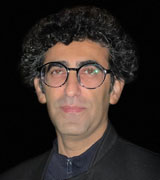Visiting Scholar Research
Professor Mohammad Reza Moridi

Visiting Scholar, Western University
Assistant Professor, Tehran University of Art
Research
I am Mohammad Reza Moridi and a faculty member of Tehran University of Arts (Iran). I research the complex relationship between art and society in the Middle East.
As a “Western Fellow” at Western University through the Visiting University Scholars Program, my research focuses on sociology of art in the Middle East. my current research is about "Art History in the Middle East and the problem of historiography of non-western art". I ask the questions: what effect do the art institutions in the Middle East (such as auction houses, museums, galleries, events and festivals) have on the contemporary art of this region? What discourses do these institutions produce and reproduce and what works of art do they accept or reject? In this way, I deal with the relationship between power, politics and art production in the formation of Middle Eastern art in the last two decades.
In my previous research, I have followed the issue of how the artists of the Islamic lands of the Middle East are inspired by the heritage of Islamic art to create contemporary art. As a visiting researcher at the Orient-Institute Beirut (OIB) in 2020, I researched "discourse of contemporary Islamic art". In that research, I explained that Middle East art is a new "narrative" of Islamic art in the age of globalization. But in this "narration" there are many doubts and questions; Do the works of Middle Eastern artists reveal their cultural and social conditions or are they stereotyped responses to Western curiosity about the Middle East? The answer to this question requires a revision of the patterns of art history under the shadow of Western art.
This short time at Western University is a valuable opportunity for me to share the results of my research.
Public Lectures
Global problem and local issues:
Environmental challenges of the petroleum industry in the works of contemporary artists of the Middle East
Friday, January 26, 2024
The countries of the Middle East are the most important beneficiaries of oil sales and gasoline consumption in the world, and of course, they face more phenomena such as sea pollution, drought, and oil pollution. This is the contradictory position of the Middle East region in terms of environmental issues. They urgently need environmental solutions but are reluctant to reduce the world's fossil fuels. Environmental artists reveal this contradiction more than politicians.
To understand the contemporary art in the Middle East, one must look at the intertwining of art and oil in this region. In this region, the fate of art is tied to oil. Living in oil cities and working at oil extraction sites in Iran, Iraq and Saudi Arabia has been the subject of many photographs, films and visual works. Some artists have created works with crude oil and petrochemical waste. Some have portrayed oil as a cultural experience and some as an environmental catastrophe.
In this research, we look at five categories of works that representation of the oil industry are tied to art:
- In some artworks, oil is a symbol of development, progress and industrial society.
- In some other artworks, oil is a symbol of working life and economic inequality.
- In the works of some artists, oil is a platform for criticizing development policies.
- For many artists, the intertwining of oil and modernization in the Middle East is a context for questioning identity.
- A few artists have dealt with oil from an environmental point of view.
In this research, we focus on environmental art and eco-art projects and works of artists have created about the petroleum industry in the Middle East and follow this question: How do artists raise public awareness of oil-related environmental problems?
Carpet as a Cultural Text:
The carpet as a context for displaying political conflicts in the Middle East
Tuesday, February 6, 2024 at 9:30 AM ET
In-person and Online
Registration required.
The carpet is a cultural symbol of the East. Carpet is an important cultural heritage for Iran, Turkey and other Middle Eastern countries. Therefore, Middle Eastern artists have dealt with the carpet as a cultural text and have created contemporary works inspired by its aesthetics, referring to its cultural heritage and appropriating it from its traditional position.
Some artists are faced with the issue of how to create a contemporary carpet. In fact, they are facing the bigger question of how can traditional arts be made contemporary? The second group of artists are faced with the issue of how they can use carpets as materials to create contemporary art. For these artists, the carpet is a symbol of traditional culture and even religious ideologies of the Middle East. Therefore, artists from Iran, Afghanistan, Iraq and Lebanon have turned the carpet into a manifesto of social criticism.
In this article, by referring to some works of contemporary artists (such as Farhad Moshiri, Jalal Sepehr, Behnam kamrani, Faig Ahmed, Abdullah Syed, Afrooz Amighi, Mona Hatoum, Rashid rana), we show how has carpet become a context to represent the cultural challenges of the Middle East.






